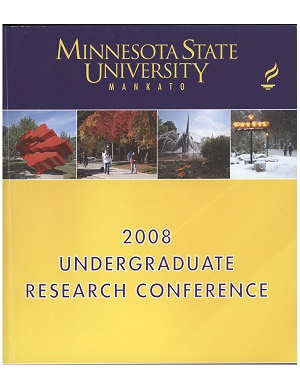Optimizing the Expression of Foreign Genes in Mycobacterium smegmatis
Location
CSU Ballroom
Start Date
21-4-2008 1:00 PM
End Date
21-4-2008 3:00 PM
Student's Major
Biological Sciences
Student's College
Science, Engineering and Technology
Mentor's Name
Timothy Secott
Mentor's Department
Biological Sciences
Mentor's College
Science, Engineering and Technology
Description
Recombinant DNA technology can be applied to the development of subunit vaccines by inserting a portion of a gene encoding a pathogen-specific antigen into a plasmid vector and introducing this construct into Escherichia coli. This organism can then synthesize the encoded protein, and this in tum can be easily purified for further testing. However, attempts to synthesize proteins from Mycobacterium (which includes the species responsible for causing tuberculosis and leprosy) have been largely unsuccessful. Previous work in our laboratory has shown that Mycobacterium smegmatis can be used in combination with derivatives of the shuttle plasmid pMV261 to successfully express recombinant proteins. The purpose of this study was to determine the important parameters necessary to optimize the expression of mycobacterial genes using this shuttle plasmid. We have obtained six M smegmatis clones that express a histidine tagged form of Mee, a gene associated with host cell invasion. To determine the optimal expression of the recombinant Mee, the initial temperature and time of incubation will be varied between 30°C, 3 7°C, and 41 °C for 48, 72, 96, and 120 hours. The temperature will then be held steady or shifted to 45°C, and samples will be collected at specific time intervals of 0, 30, 60, and 120 minutes following the temperature shift. This information is expected to be useful for the preparation of other mycobacterial antigens that could be useful for the as diagnostic reagents or as subunit vaccines against mycobacterial infections.
Optimizing the Expression of Foreign Genes in Mycobacterium smegmatis
CSU Ballroom
Recombinant DNA technology can be applied to the development of subunit vaccines by inserting a portion of a gene encoding a pathogen-specific antigen into a plasmid vector and introducing this construct into Escherichia coli. This organism can then synthesize the encoded protein, and this in tum can be easily purified for further testing. However, attempts to synthesize proteins from Mycobacterium (which includes the species responsible for causing tuberculosis and leprosy) have been largely unsuccessful. Previous work in our laboratory has shown that Mycobacterium smegmatis can be used in combination with derivatives of the shuttle plasmid pMV261 to successfully express recombinant proteins. The purpose of this study was to determine the important parameters necessary to optimize the expression of mycobacterial genes using this shuttle plasmid. We have obtained six M smegmatis clones that express a histidine tagged form of Mee, a gene associated with host cell invasion. To determine the optimal expression of the recombinant Mee, the initial temperature and time of incubation will be varied between 30°C, 3 7°C, and 41 °C for 48, 72, 96, and 120 hours. The temperature will then be held steady or shifted to 45°C, and samples will be collected at specific time intervals of 0, 30, 60, and 120 minutes following the temperature shift. This information is expected to be useful for the preparation of other mycobacterial antigens that could be useful for the as diagnostic reagents or as subunit vaccines against mycobacterial infections.
Recommended Citation
Casey, Ben. "Optimizing the Expression of Foreign Genes in Mycobacterium smegmatis." Undergraduate Research Symposium, Mankato, MN, April 21, 2008.
https://cornerstone.lib.mnsu.edu/urs/2008/poster-session-B/3




